Exam Details
Exam Code
:USMLE-STEP-1Exam Name
:United States Medical Licensing Step 1Certification
:USMLE CertificationsVendor
:USMLETotal Questions
:847 Q&AsLast Updated
:Apr 17, 2025
USMLE USMLE Certifications USMLE-STEP-1 Questions & Answers
-
Question 621:
The electrocardiogram of a 66-year-old male with a history of atherosclerotic heart disease reveals an irregular, but rapid heart rate. The QRS complexes are normal but no P-waves can be seen. What is the most likely reason for these findings?
A. atrial fibrillation
B. Paroxysmal ventricular tachycardia
C. Right bundle branch block
D. Sinus tachycardia
E. Wolff-Parkinson-White syndrome
-
Question 622:
A newlywed 23-year-old woman and her 28-year-old husband are evaluated for infertility. They have been unable to conceive a child despite regular intercourse for the past 12 months. The first step of this couple's infertility workup is to determine whether ovulation occurs regularly. Which of the following hormones is directly responsible for ovulation?
A. estradiol
B. estriol
C. follicle-stimulating hormone (FSH)
D. inhibin
E. luteinizing hormone (LH)
-
Question 623:
Exhibit:
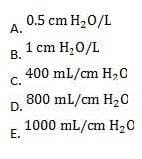
The graph in below figure shows the static pressurevolume curve of a patient's lung (solid line). The broken line indicates the pressurevolume curve of a normal person for comparison. What is the approximate lung compliance of this patient over the volume range from 1 to 7 L?
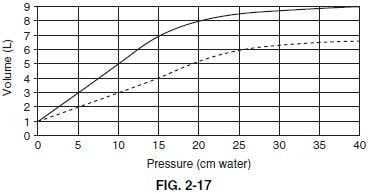
A. A
B. B
C. C
D. D
E. E
-
Question 624:
Exhibit #1: Missing Exhibit #2:
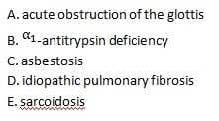
The data in below figure indicate that the lung compliance in this patient (solid line) is altered relative to the norm. This patient is most likely suffering from which of the following conditions?
A. A
B. B
C. C
D. D
E. E
-
Question 625:
Lambert-Eaton myasthenic syndrome (LEMS) is an autoimmune disorder in which autoantibodies attack voltage-gated calcium channels in the presynaptic nerve terminal. A characteristic manifestation of LEMS is limb muscle weakness. A decrease in which of the following would you expect to see in LEMS?
A. activation threshold for the action potential
B. amplitude of the action potential
C. amplitude of the miniature end-plate potential (MEPP)
D. magnitude of the end-plate potential (EPP)
E. quantal content
-
Question 626:
Which of the following conditions would likely be associated with decreased levels of circulating EPO?
A. chronic alkalosis
B. chronic renal failure
C. emphysema
D. pernicious anemia
E. pulmonary fibrosis
-
Question 627:
Multiple sclerosis is a relatively common nervous system demyelinating disease. It is autoimmune and restricted to the central nervous system. Nerve conduction velocity is depressed in almost all affected individuals. Manipulations which prolong action potential duration seem to mitigate symptoms, possibly by facilitating conduction through sections of membrane which are no longer myelinated. Application of which type of drug might be expected to prolong action potential duration and thus be a potential therapeutic tool?
A. activates potassium channels
B. blocks L-type calcium channels
C. blocks potassium channels
D. blocks sodium channels
E. increases sodium channel inactivation
-
Question 628:
Apatient is found to be deficient in folate. This patient is anemic, and a complete blood count indicates that the MCV is 105 fL (normal range: 8096) and the MCHC is 34 g/dL (normal range: 3236). The anemia is thus macrocytic, normochromic. In this patient how would you predict that the MCH (mean corpuscular hemoglobin) would compare with the normal range?
A. MCH would be elevated with respect to the normal range
B. MCH would be depressed with respect to the normal range
C. MCH would be within the normal range
D. this cannot be determined based on the information provided
-
Question 629:
You are the primary care physician for a young female college student. She has been engaged over the past 3 months in a vigorous aerobic exercise training regime that includes a significant amount of running in a hot environment. You measure her hematocrit as part of a general physical examination. Her hematocrit could well be abnormal even though she is not anemic. Which of the following choices best fits this profile?
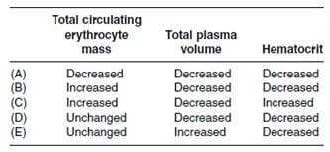
A. Option A
B. Option B
C. Option C
D. Option D
E. Option E
-
Question 630:
A 66-year-old male presents with angina and dyspnea on exertion. Auscultation of the chest reveals a loud systolic murmur. He is diagnosed with aortic valvular sclerosis. This stenosis of the aortic valve will cause a murmur that can be heard loudest at which interval shown in below figure?
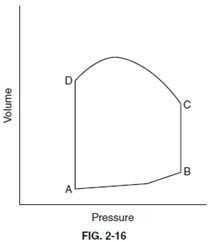
A. between A and B
B. between B and C
C. between C and D
D. between D and A
E. between D and B
Tips on How to Prepare for the Exams
Nowadays, the certification exams become more and more important and required by more and more enterprises when applying for a job. But how to prepare for the exam effectively? How to prepare for the exam in a short time with less efforts? How to get a ideal result and how to find the most reliable resources? Here on Vcedump.com, you will find all the answers. Vcedump.com provide not only USMLE exam questions, answers and explanations but also complete assistance on your exam preparation and certification application. If you are confused on your USMLE-STEP-1 exam preparations and USMLE certification application, do not hesitate to visit our Vcedump.com to find your solutions here.